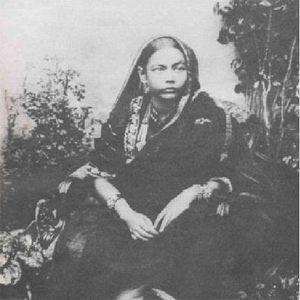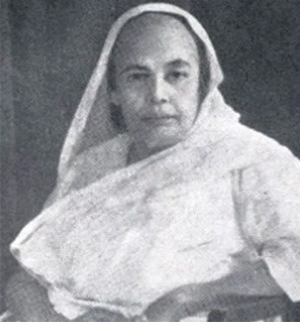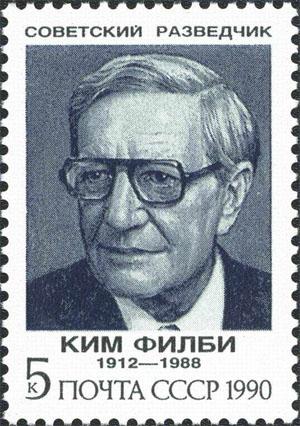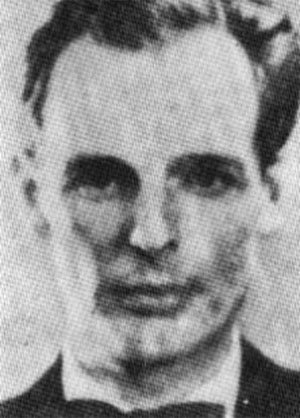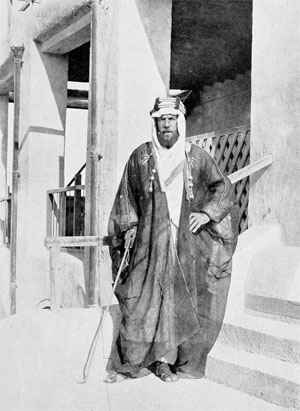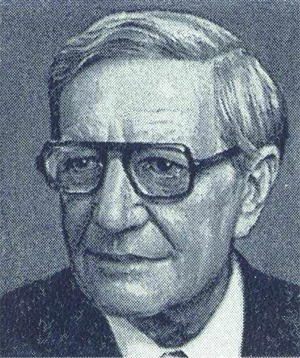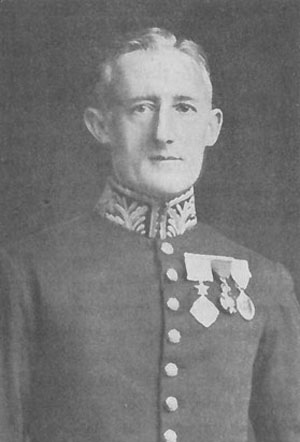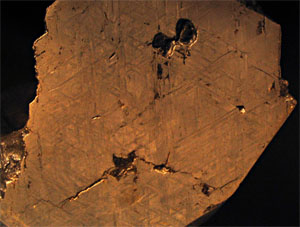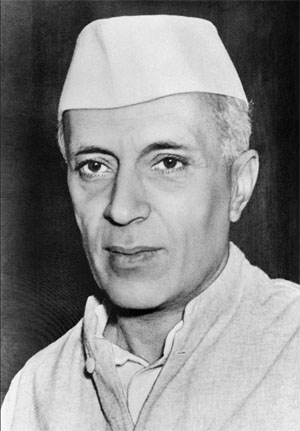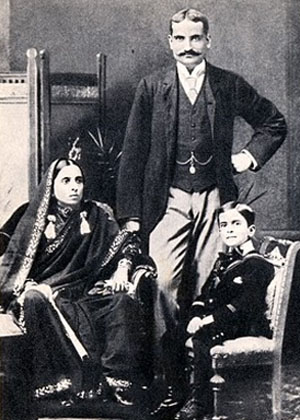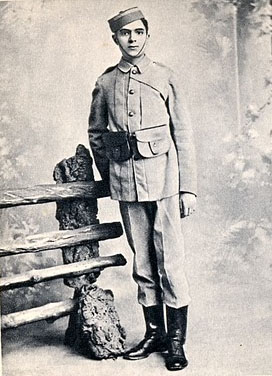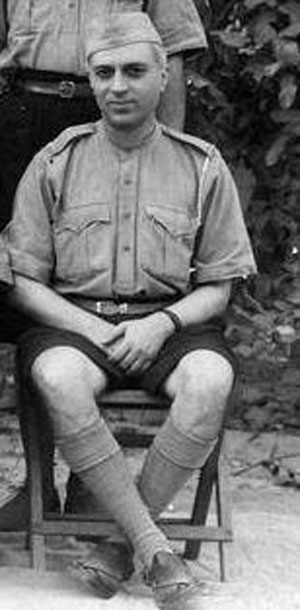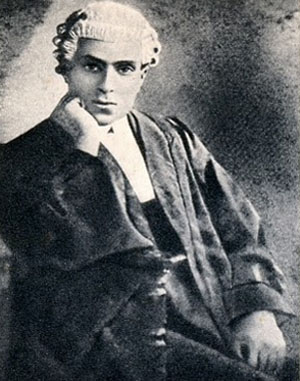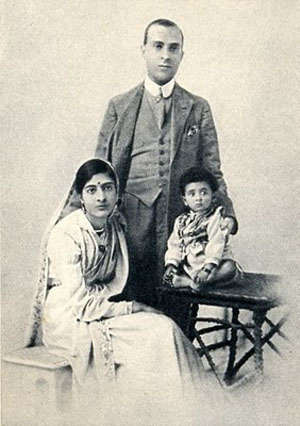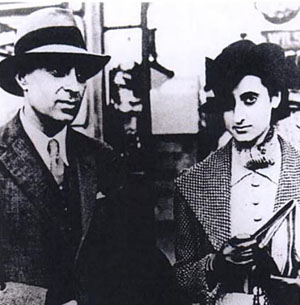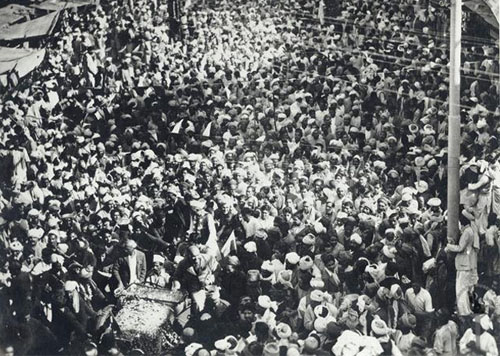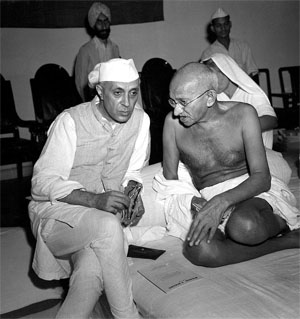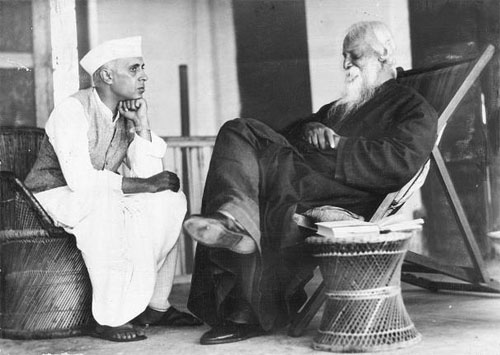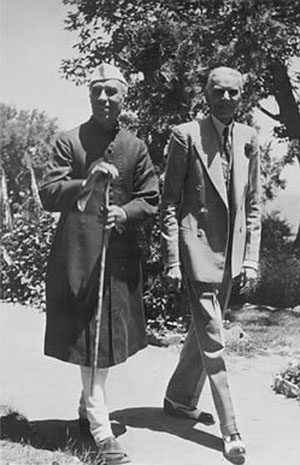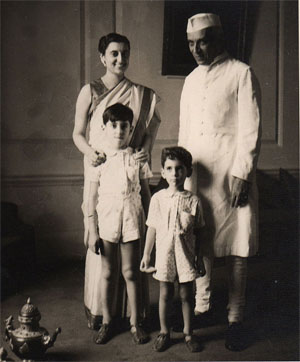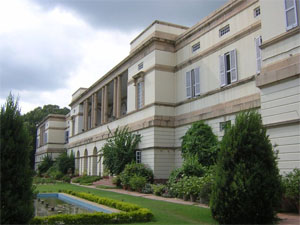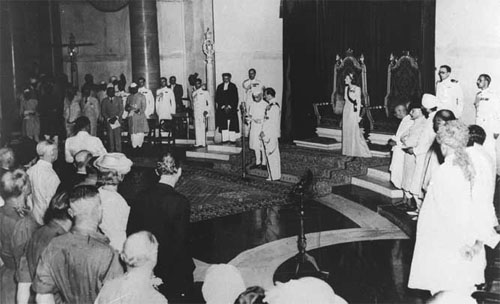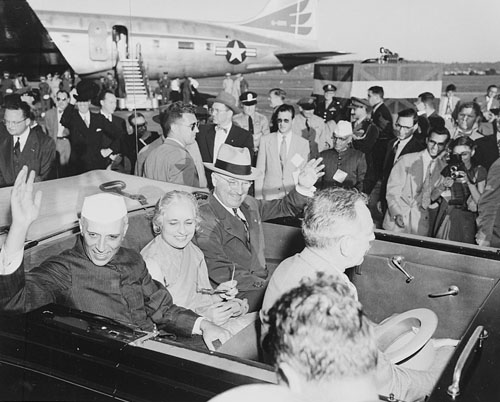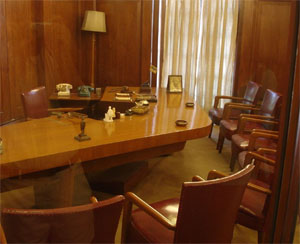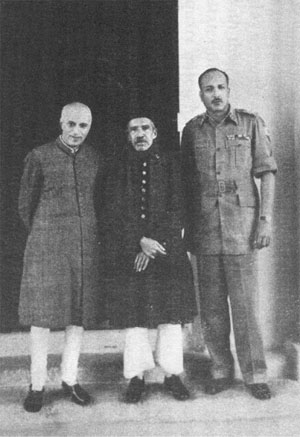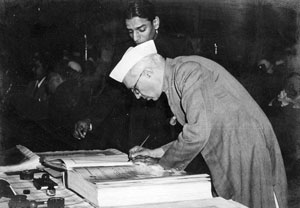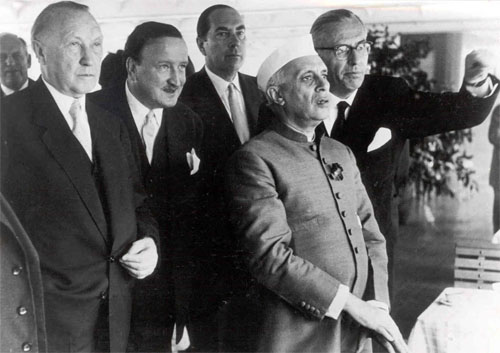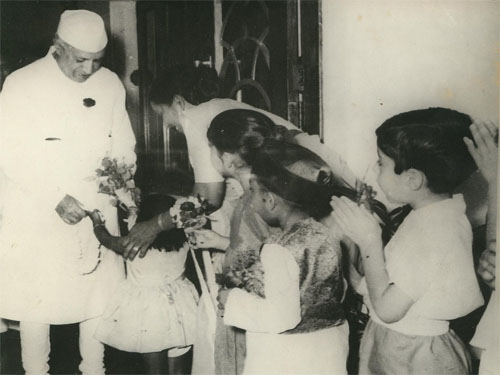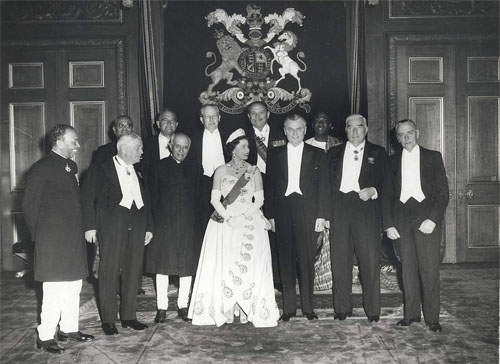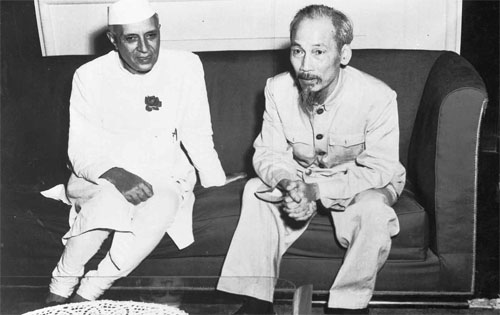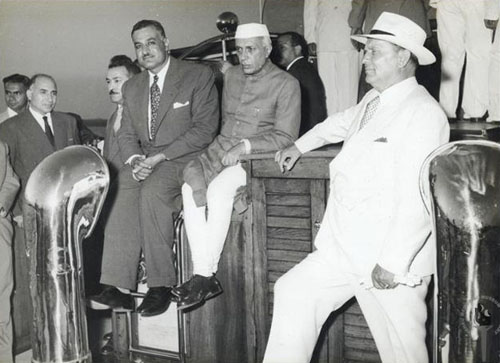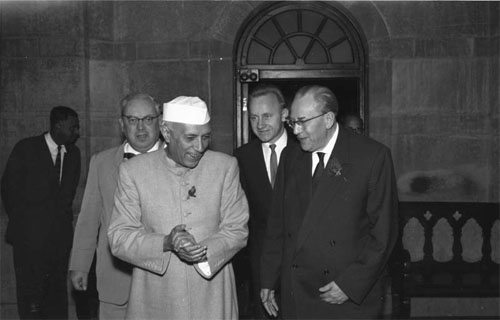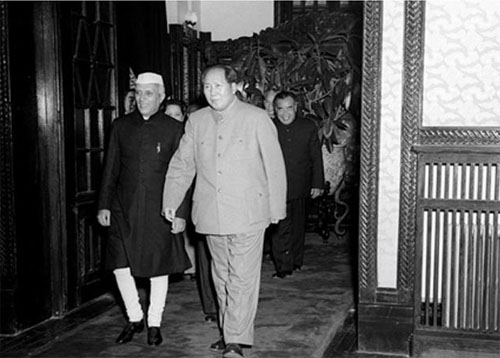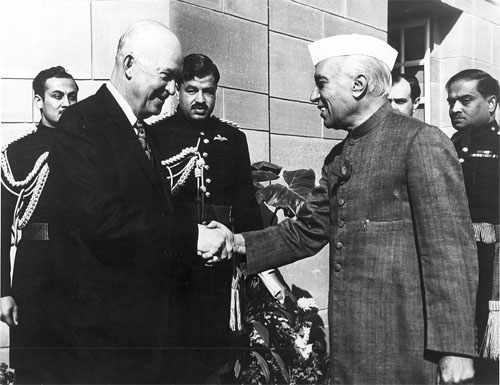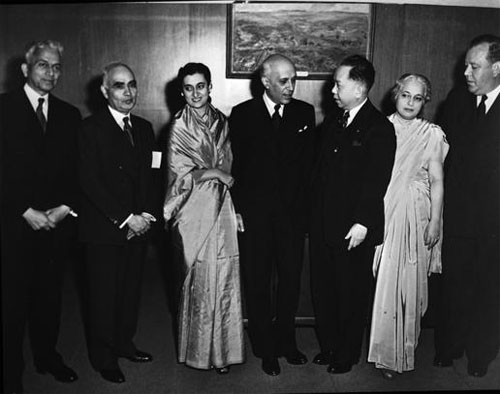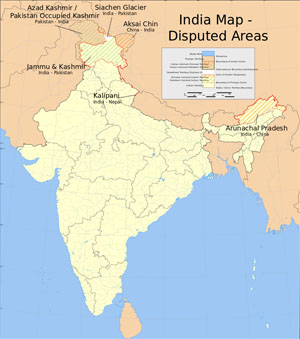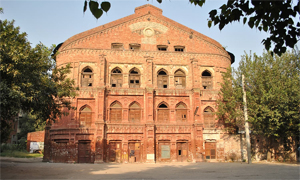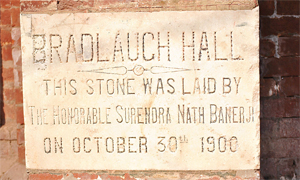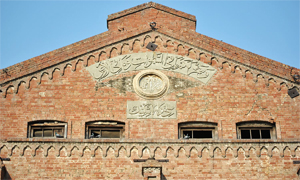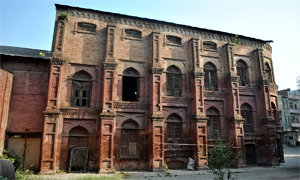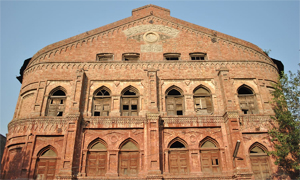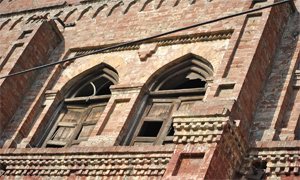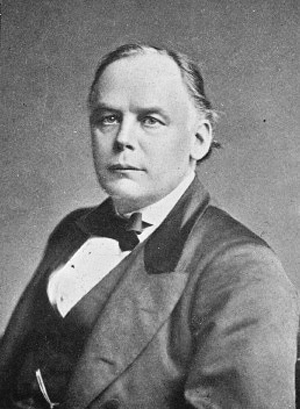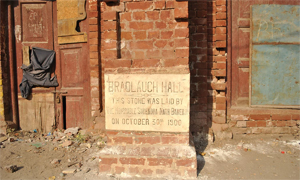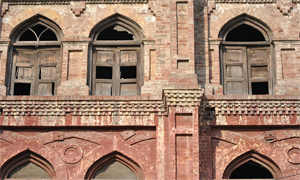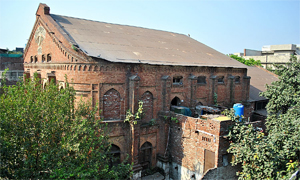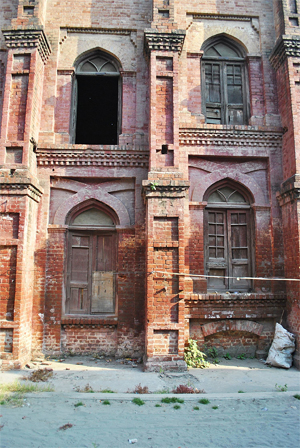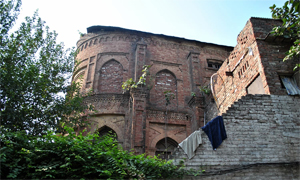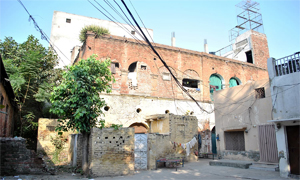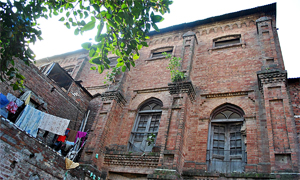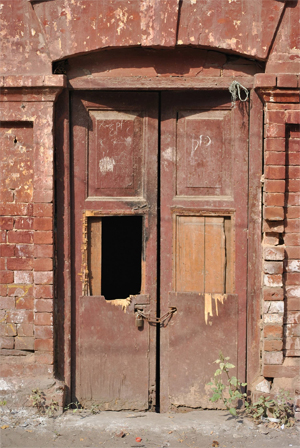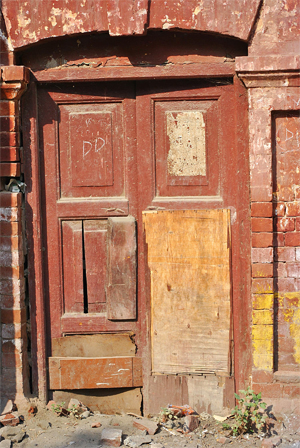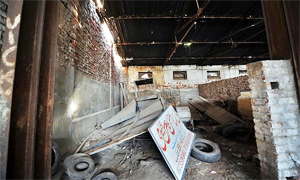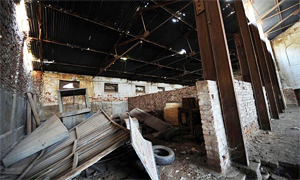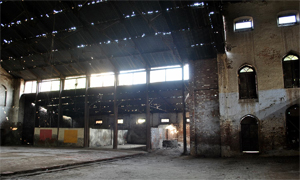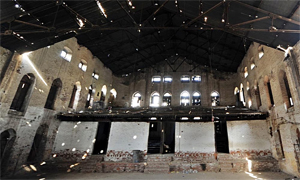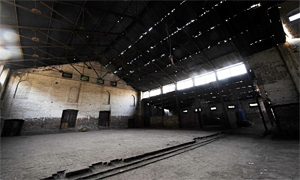Part 4 of 4
Personal life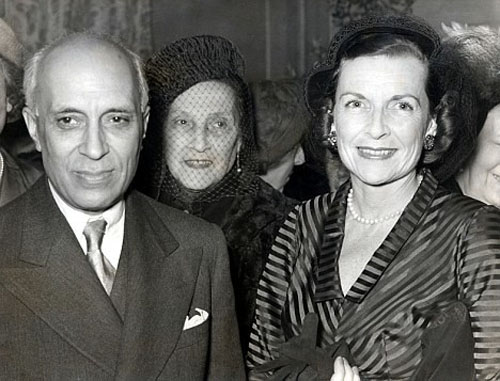 Prime Minister Nehru with Edwina Mountbatten in 1951
Prime Minister Nehru with Edwina Mountbatten in 1951Nehru married Kamala Kaul in 1916. Their only daughter Indira was born a year later in 1917. Kamala gave birth to a boy in November 1924, but he lived for only a week.[218] Indira married Feroze Gandhi in 1942. They had two sons – Rajiv (b. 1944) and Sanjay (b. 1946).
After Kamala's death in 1936, Nehru was rumoured to have relationships with several women. These included Shraddha Mata,[219] Padmaja Naidu[220][221] and Edwina Mountbatten.[222] Edwina's daughter Pamela acknowledged Nehru's platonic relationship with Edwina.[223] Nehru sent an Indian Navy frigate to the sea burial of Edwina Mountbatten in 1960.[224]
British historian Philip Ziegler, with access to the private letters and diaries, concludes the relationship:
was to endure until Edwina Mountbatten's death: intensely loving, romantic, trusting, generous, idealistic, even spiritual. If there was any physical element it can only have been of minor importance to either party. [India's Governor-General] Mountbatten's reaction was one of pleasure....He liked and admired Nehru, it was useful to him that the Prime Minister should find such attractions in the Governor-General's home, it was agreeable to find Edwina almost permanently in good temper: the advantages of the alliance were obvious. [225]
Nehru's sister, Vijaya Lakshmi Pandit told Pupul Jayakar, Indira Gandhi's friend and biographer, that Padmaja Naidu and Nehru lived together for many years.[226][227]
During most of Nehru's tenure as the prime minister, Indira served her father unofficially as a personal assistant.[228] Towards the end of the 1950s, Indira Gandhi served as the President of the Congress. In that capacity, she was instrumental in getting the Communist led Kerala State Government dismissed in 1959.[229]
Religion and personal beliefs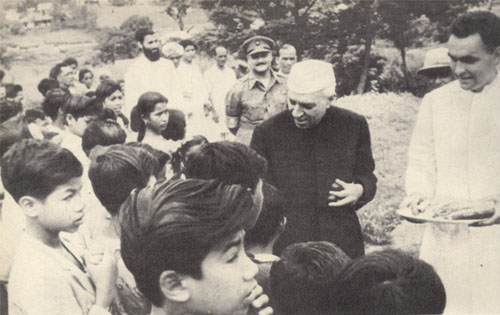 Nehru distributes sweets among children at Nongpoh, Meghalaya
Nehru distributes sweets among children at Nongpoh, MeghalayaDescribed as Hindu Agnostic,[230] and styling himself as a "scientific humanist",[231] Nehru thought that religious taboos were preventing India from going forward and adapting to modern conditions: "No country or people who are slaves to dogma and dogmatic mentality can progress, and unhappily our country and people have become extraordinarily dogmatic and little-minded."[232]
The spectacle of what is called religion, or at any rate organised religion, in India and elsewhere, has filled me with horror and I have frequently condemned it and wished to make a clean sweep of it. Almost always it seemed to stand for blind belief and reaction, dogma and bigotry, superstition, exploitation and the preservation of vested interests.
— Toward Freedom: The Autobiography of Jawaharlal Nehru (1936); pp. 240–241.[233]
In his autobiography, he analysed Christianity[234] and Islam,[235] and their impact on India. He wanted to model India as a secular country; his secularist policies remain a subject of debate.[236][237]
LegacyFurther information: List of things named after Jawaharlal Nehru
Nehru was a great man... Nehru gave to Indians an image of themselves that I don't think others might have succeeded in doing. – Sir Isaiah Berlin[238]
 Bust of Nehru at Aldwych, London
Bust of Nehru at Aldwych, London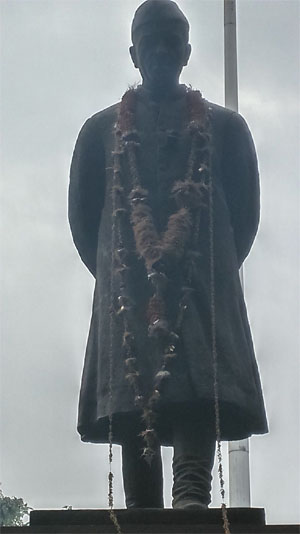 Statue of Nehru at Park Street, Kolkata
Statue of Nehru at Park Street, KolkataAs India's first Prime minister and external affairs minister, Jawaharlal Nehru played a major role in shaping modern India's government and political culture along with sound foreign policy. He is praised for creating a system providing universal primary education,[239] reaching children in the farthest corners of rural India. Nehru's education policy is also credited for the development of world-class educational institutions such as the All India Institute of Medical Sciences,[240] Indian Institutes of Technology,[241] and the Indian Institutes of Management.
In addition, Nehru's stance as an unfailing nationalist led him to also implement policies which stressed commonality among Indians while still appreciating regional diversities. This proved particularly important as post-Independence differences surfaced since British withdrawal from the subcontinent prompted regional leaders to no longer relate to one another as allies against a common adversary. While differences of culture and, especially, language threatened the unity of the new nation, Nehru established programs such as the National Book Trust and the National Literary Academy which promoted the translation of regional literatures between languages and also organised the transfer of materials between regions. In pursuit of a single, unified India, Nehru warned, "Integrate or perish."[242]
Historian Ramachandra Guha writes, "[had] Nehru retired in 1958 he would be remembered as not just India's best prime minister, but as one of the great statesmen of the modern world."[243] Nehru, thus, left behind a disputed legacy, being "either adored or reviled for India's progress or lack of it".[244]
Commemoration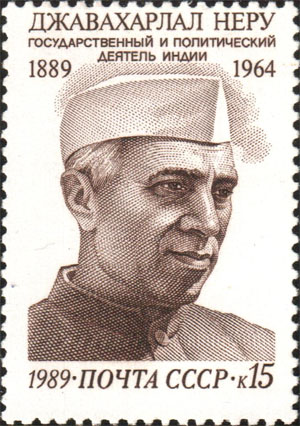 Jawaharlal Nehru on a 1989 USSR commemorative stamp
Jawaharlal Nehru on a 1989 USSR commemorative stampIn his lifetime, Jawaharlal Nehru enjoyed an iconic status in India and was widely admired across the world for his idealism and statesmanship.[245][246] His birthday, 14 November is celebrated in India as Bal Divas ("Children's Day") in recognition of his lifelong passion and work for the welfare, education and development of children and young people. Children across India remember him as Chacha Nehru (Uncle Nehru).[247] Nehru remains a popular symbol of the Congress Party which frequently celebrates his memory. Congress leaders and activists often emulate his style of clothing, especially the Gandhi cap and the "Nehru jacket", and his mannerisms.[246] Nehru's ideals and policies continue to shape the Congress Party's manifesto and core political philosophy.[247] An emotional attachment to his legacy was instrumental in the rise of his daughter Indira to leadership of the Congress Party and the national government.
In 2012, Nehru was ranked number 4 in Outlook's poll of The Greatest Indian.[248]
Nehru's personal preference for the sherwani ensured that it continues to be considered formal wear in North India today; aside from lending his name to a kind of cap, the Nehru jacket is named in his honour because of his preference for that style.[249]
Numerous public institutions and memorials across India are dedicated to Nehru's memory. The Jawaharlal Nehru University in Delhi is among the most prestigious universities in India. The Jawaharlal Nehru Port near the city of Mumbai is a modern port and dock designed to handle a huge cargo and traffic load. Nehru's residence in Delhi is preserved as the Teen Murti House now has Nehru Memorial Museum & Library, and one of five Nehru Planetariums that were set in Mumbai, Delhi, Bangalore, Allahabad and Pune. The complex also houses the offices of the 'Jawaharlal Nehru Memorial Fund', established in 1964 under the Chairmanship of Sarvepalli Radhakrishnan, then President of India. The foundation also gives away the prestigious 'Jawaharlal Nehru Memorial Fellowship', established in 1968.[250] The Nehru family homes at Anand Bhavan and Swaraj Bhavan are also preserved to commemorate Nehru and his family's legacy.
In popular cultureMany documentaries about Nehru's life have been produced. He has also been portrayed in fictionalised films. The canonical performance is probably that of Roshan Seth, who played him three times: in Richard Attenborough's 1982 film Gandhi, Shyam Benegal's 1988 television series Bharat Ek Khoj, based on Nehru's The Discovery of India, and in a 2007 TV film entitled The Last Days of the Raj.[251] In Ketan Mehta's film Sardar,[252] Nehru was portrayed by Benjamin Gilani. Girish Karnad's historical play, Tughlaq (1962) is an allegory about the Nehruvian era. It was staged by Ebrahim Alkazi with National School of Drama Repertory at Purana Qila, Delhi in the 1970s and later at the Festival of India, London in 1982.[253][254]
WritingsNehru was a prolific writer in English and wrote a number of books, such as The Discovery of India, Glimpses of World History, and his autobiography, Toward Freedom. He had written 30 letters to his daughter Indira Gandhi, when she was 10 years old and in a boarding school in Mussoorie, teaching about natural history and the story of civilisations. The collection of these letters was later published as a book Letters from a Father to His Daughter.[255]
AwardsIn 1955, Nehru was awarded the Bharat Ratna, India's highest civilian honour.[256] President Rajendra Prasad awarded him the honour without taking advice from the Prime Minister as would be the normal constitutional procedure.[257]
See also• Biography portal
• Politics portal
• India portal
• List of political families
• Scientific temper, a system of scientific thinking introduced by Nehru
References1. "Nehru" Archived 5 March 2016 at the Wayback Machine. Random House Webster's Unabridged Dictionary.
2. Gabrielle Eva Marie Zezulka-Mailloux; James Gifford (2003). Culture + the State: Nationalisms. CRC Studio. p. 120. ISBN 978-1-55195-149-2.
3. "Indian National Congress". inc.in. Archived from the original on 5 March 2016.
4. "Nation pays tribute to Pandit Jawaharlal Nehru on his 124th birth anniversary | Latest News & Updates at Daily News & Analysis". dna. 14 November 2013. Archived from the original on 1 July 2017. Retrieved 18 May 2017.
5. Moraes 2007, p. 4.
6. Zakaria, Rafiq A Study of Nehru, Times of India Press, 1960, p. 22
7. Moraes 2007.
8. Bonnie G. Smith; The Oxford Encyclopedia of Women in World History. Oxford University Press. 2008. ISBN 978-0195148909. pp. 406–407.
9. Moraes 2007, p. 22.
10. Om Prakash Misra; Economic Thought of Gandhi and Nehru: A Comparative Analysis. M.D. Publications. 1995. ISBN 978-8185880716. pp. 49–65.
11. Moraes 2007, p. 23.
12. Bal Ram Nanda; The Nehrus. Oxford University Press. 1962. ISBN 978-0195693430. p. 65.
13. Bharathi, K. S. (1998). Encyclopaedia of eminent thinkers. ISBN 9788170226840.
14. Moraes 2007, p. 36.
15. Moraes 2007, p. 43.
16. Sen, Z.K.C., 1964. Jawaharlal Nehru. Civilisations, pp. 25–39 Archived 13 April 2018 at the Wayback Machine
17. Moraes 2007, p. 47.
18. Moraes 2007, p. 37.
19. Ghose 1993, p. 25.
20. Moraes 2007, p. 49.
21. Moraes 2007, p. 50.
22. In Jawaharlal Nehru's autobiography, An Autobiography (1936) p. 33.
23. Moraes 2007, p. 52.
24. Moraes 2007, p. 53.
25. Ghose 1993, p. 26.
26. Nehru, Jawaharlal Glimpses of world history: being further letters to his daughter (Lindsay Drummond Ltd., 1949), p. 94
27. Moraes 2007, p. 56.
28. Moraes 2007, p. 55.
29. "Jawaharlal Nehru – a chronological account". Archived from the original on 4 June 2012. Retrieved 23 June 2012.
30. Pratiyogita Darpan Editorial Board. Indian National Movement & Constitutional Development. Pratiyogita Darpan Extra Issue Series, Volume 12. Upkar Prakashan. Retrieved 2 October 2018.
31. The Literary Works of Ranganathan Magadi. ISBN 9780557044009.
32. Moraes 2007, p. 115.
33. Roland, Joan G. (2 June 1998). The Jewish Communities of India: Identity in a Colonial Era (Second ed.). Routledge. p. 193. ISBN 978-0765804396.
34. Hoiberg, Dale (2000). Students' Britannica India. Popular Prakashan. p. 108. ISBN 9780852297605.
35. Dale Hoiberg (2000). Students' Britannica India. Popular Prakashan. pp. 108–. ISBN 978-0-85229-760-5.
36. "Eighty Years Later, A Homage to Catalonia: Indians and the Spanish Civil War".
37. Moraes 2007, p. 77.
38. Moraes 2007, p. 266.
39. "Nehru went to jail for Sikhs, Hooda is playing politics with them".
40. "Nehru's Nabha jail ordeal lost in past". 15 November 2014.
41. Chowdhary, Rekha (5 October 2015). Jammu and Kashmir: Politics of identity and separatism. ISBN 9781317414056.
42. Śekhara Bandyopādhyāẏa (2004). From Plassey to Partition: A History of Modern India. Orient Blackswan. p. 410. ISBN 978-81-250-2596-2.
43. Lumby 1954, p. 232
44. Brown 1984, p. 667
45. Sinha, Shakti; Roy, Himanshu (5 November 2018). Patel: Political Ideas and Policies. ISBN 9789352808540.
46. Lumby, E.W.R. (1954), The Transfer of Power in India, 1945–1947, London: George Allen and Unwin p. 228
47. Shakti Sinha; Himanshu Roy (5 November 2018). Patel: Political Ideas and Policies. SAGE Publications. pp. 170–. ISBN 978-93-5280-854-0.
48. "56 events that changed India: Dissolution of princely states in 1950".
49. Dutt, R.C. (1981). Socialism of Jawaharlal Nehru. New Delhi: Shakti Malik, Abhinav Publications. pp. 54–55. ISBN 9788170171287. Retrieved 8 September 2017.
50. Rajmohan Gandhi, Patel: A Life, p. 171, ASIN: B0006EYQ0A
51. Nag, Kingshuk (18 November 2015). Netaji: Living Dangerously. ISBN 9789384439705.
52. R. Gandhi, Patel: A Life, p. 185
53. "Purna Swaraj: The Demand for Full Independence 26 January 1930". India of the Past. Retrieved 6 July2015.
54. "Declaration of independence". Archived from the original on 17 May 2013. Retrieved 14 August 2012.
55. "Republic Day story: On Ravi's banks, a pledge that shaped the course of modern India 88 years ago".
56. Education, Pearson. SSC topic-wise Previous Years Solved Papers General Awareness. ISBN 9789352866403.
57. "Enter Rahul brand of Congress". 5 December 2017.
58. Gandhi, Gopalkrishna. "The Great Dandi March — eighty years after" Archived 17 July 2012 at the Wayback Machine, The Hindu, 5 April 2010
59. Moraes 2007, p. 167.
60. Moraes, Frank (1 January 2007). Jawaharlal Nehru. Jaico Publishing House. ISBN 978-817992695-6. Retrieved 9 November 2018.
61. Fisher, Margaret W. (June 1967). "India's Jawaharlal Nehru" p. 368.
62. Johnson, Richard L. (2005). Gandhi's Experiments With Truth: Essential Writings By And About Mahatma Gandhi, Lexington Books, ISBN 0739111426 p. 37
63. Maheshwari, Neerja (1997). Economic Policy of Jawaharlal Nehru. Deep & Deep. ISBN 978-817100850-6. Retrieved 9 November 2018.
64. Kochar, R. C. (1997). Congress and Socialism: Economic Programmes and Policies. ISBN 9788186565247.
65. Moraes 2007, p. 196.
66. BN Pandey (Editor) (22 December 2015). The Indian Nationalist Movement 1885–1947: Select Documents. Springer. p. 45. ISBN 978-1-349-86215-3.
67. Rabindra Chandra Dutt (1981). Socialism of Jawaharlal Nehru. Abhinav Publications. p. 178. ISBN 978-81-7017-128-7.
68. Congress
69. Moraes 2007, p. 234-238.
70. "How Gandhi softened stance towards Bose". The Tribune. 11 October 2016. Retrieved 2 October 2018.
71. "THE CONSTITUTION (AMENDMENT)". indiacode.nic.in. Archived from the original on 28 March 2015. Retrieved 18 May 2017.
72. "Secularism: Why Nehru dropped and Indira inserted the S-word in the Constitution". 27 December 2017.
73. Moraes 2007, p. 129.
74. "3rd Five Year Plan (Chapter 1)". Government of India. Archived from the original on 26 March 2012. Retrieved 16 June 2012.
75. "Past Continuous: Those Who Think Nehru Was Power Hungry Should Review Events Leading to Independence".
76. Hoiberg, Dale (2000). Students' Britannica India. Popular Prakashan. p. 107. ISBN 9780852297605.
77. Barbara D. Metcalf; Thomas R. Metcalf (28 September 2006). A Concise History of Modern India. Cambridge University Press. p. 176. ISBN 978-1-139-45887-0.
78. B. R. Tomlinson (18 June 1976). The Indian National Congress and the Raj, 1929–1942: The Penultimate Phase. Palgrave Macmillan UK. pp. 57–60. ISBN 978-1-349-02873-3.
79. Thakur, Pradeep. The Most Important People of the 20th Century (Part-I): Leaders & Revolutionaries. ISBN 9780557778867.
80. Experts, Disha (19 August 2017). CSAT Paper 1 General Studies 101 Speed Tests with 10 Practice Sets – 3rd Edition. ISBN 9789386323507.
81. Bandyopadhyay, Sekhara (2004). From Plassey to Partition: A History of Modern India. India: Orient Longman. p. 412. ISBN 978-81-250-2596-2.
82. Moraes, Frank R. "Jawaharlal Nehru". Encyclopædia Britannica. Retrieved 2 October 2018.
83. Bhatnagar, Dr S. K. (25 October 2018). UPPSC Medical Officer Recruitment Examination Part-1: General Knowledge Homeopathic/Ayurvedic. Prabhat Prakashan. ISBN 9789353220549 – via Google Books.
84. Sears, Stephen W. (10 September 2014). The British Empire. New Word City. ISBN 9781612308098 – via Google Books.
85. History, Amy McKenna Senior Editor, Geography and (20 December 2009). The 100 Most Influential World Leaders of All Time. The Rosen Publishing Group, Inc. ISBN 9781615300150 – via Google Books.
86. Hoiberg, Dale (19 December 2018). Students' Britannica India. Popular Prakashan. ISBN 9780852297605 – via Google Books.
87. Mansergh, Nicholas (21 August 2013). Survey of British Commonwealth Affairs: Problems of Wartime Cooperation and Post-War Change 1939–1952. Routledge. ISBN 9781136242892 – via Google Books.
88. "The National Archives – Homepage".
89. Science & culture, Volume 30. Indian Science News Association. 1964.
90. Aditit De (8 September 2009). Jawaharlal Nehruh – The Jewel of India. Puffin Books. ISBN 9788184758665 – via Google Books.
91. Aamir R. Mufti (10 January 2009). Enlightenment in the Colony: The Jewish Question and the Crisis of Postcolonial Culture. Princeton University Press. pp. 129–131. ISBN 978-1-4008-2766-4.
92. History, Amy McKenna Senior Editor, Geography and (20 December 2009). The 100 Most Influential World Leaders of All Time. The Rosen Publishing Group, Inc. ISBN 9781615300150 – via Google Books.
93. Civics & History. Pitambar Publishing. ISBN 9788120910881 – via Google Books.
94. Gandhi, Mahatma (1994). The Gandhi Reader: A Sourcebook of His Life and Writings. ISBN 9780802131614.
95. Sears, Stephen W. (10 September 2014). The British Empire. ISBN 9781612308098.
96. Meena Gaikwad, Dr. The Ideas of Modern Indian Political Thinkers on Women. ISBN 9781387477685.
97. Agrawal, Lion M. G. (2008). Freedom fighters of India. ISBN 9788182054707.
98. Wikisource:A Tryst With Destiny
99. Thakur, Pradeep. The Most Important People of the 20th Century (Part-I): Leaders & Revolutionaries. ISBN 9780557778867.
100. Janak Raj Jai (1996). 1947–1980. Regency Publications. pp. 45–47. ISBN 978-81-86030-23-3.
101. Nehru's address on Gandhi's death. Retrieved 15 March 2007.
102. Zachariah, Benjamin (2 September 2004). Nehru. ISBN 9781134577408.
103. Yasmin Khan 2011
104. Thapar, Karan (17 August 2009). "Gandhi, Jinnah both failed: Jaswant". ibnlive.in.com. Archived from the original on 3 July 2014.
105. "After Advani, Jaswant turns Jinnah admirer". The Economic Times. India. 17 August 2009. Archivedfrom the original on 20 October 2017.
106. Ghosh, Bishwanath (17 March 2016). "Maps are malleable. Even Bharat Mata's". The Hindu.
107. "Five states that refused to join India after Independence". 17 August 2017.
108. Sinha, Shakti; Roy, Himanshu (5 November 2018). Patel: Political Ideas and Policies. ISBN 9789352808540.
109. "Special status for Delhi, Puducherry, but President word final – Times of India".
110. Myron Weiner (8 December 2015). Party Politics in India. Princeton University Press. pp. 78–79. ISBN 978-1-4008-7841-3.
111. Varshney, Ashutosh (updated 28 March 2015) Faults and lines. Indianexpress.com. Retrieved on 12 December 2018.
112. "STATE OF THE NATION – Indian Express".
113. Koshi, Luke (2 November 2016). "Explainer: The reorganization of states in India and why it happened". The News Minute. Retrieved 3 April 2019.
114. Meena Gaikwad, Dr. The Ideas of Modern Indian Political Thinkers on Women. ISBN 9781387477685.
115. Parekh, Bhiku (1991). "Nehru and the National Philosophy of India". Economic and Political Weekly. 26 (5–12 Jan. 1991): 35–48. JSTOR 4397189.
116. Ghose 1993, p. 243.
117. Kopstein 2005, p. 364.
118. Walsh, Judith E. (2006). A Brief History of India. Infobase Publishing. p. 190. ISBN 978-1438108254.
119. Yokokawa, Nobuharu; Jayati Ghosh; Bob Rowthorn (2013). Industrialization of China and India: Their Impacts on the World Economy. Routledge. p. 213. ISBN 978-1134093878.
120. Grabowski, Richard; Sharmistha Self; Michael P. Shields (2007). Economic Development: A Regional, Institutional, And Historical Approach. M.E. Sharpe. p. 161. ISBN 978-1134093878.
121. Shand, R. Richard Tregurtha; K. P. Kalirajan; Ulaganathan Sankar (2003). Economic Reform and the Liberalisation of the Indian Economy: Essays in Honour of Richard T. Shand; papers Presented at a Major Conference on Second Generation Reforms in Chennai from 8 – 10 December 1999. Edward Elgar Publishing. p. 39. ISBN 978-1781959435.
122. Thakur, Anil Khumar; Debes Mukhopadhayay (2010). Economic Philosophy of Jawaharlal Nehru. Deep and Deep Publications. p. 14. ISBN 978-8184502725.
123. Chandra, Bipan; Aditya Mukherjee; Mridula Mukherjee (2008). India Since Independence. Penguin Books India. p. 449. ISBN 978-0143104094.
124. Kapila, Uma (2009). Indian Economic Developments Since 1947 (3Rd Ed.). Academic Foundation. p. 132. ISBN 978-8171887118.
125. Kapila, Uma (2009). Indian Economic Developments Since 1947 (3Rd Ed.). Academic Foundation. p. 66. ISBN 978-8171887118.
126. Giersch, Herbert; Karl-Heinz Paqué; Holger Schmieding (1994). The Fading Miracle: Four Decades of Market Economy in Germany. Cambridge University Press. p. 4. ISBN 978-0521358699.
127. Kopstein 2005, p. 366.
128. Parker, Randall E.; Robert M. Whaples (2013). The Routledge Handbook of Major Events in Economic History. Routledge. p. 306. ISBN 978-0415677035.
129. Daniel Yergin; Joseph Stanislaw (15 June 2002). The Commanding Heights: The Battle for the World Economy. Simon and Schuster. ISBN 978-0-7432-2963-0.
130. Brown, Judith M. (17 June 2014). Nehru. ISBN 9781317874768.
131. Ashutosh Varshney (18 September 1998). Democracy, Development, and the Countryside: Urban-Rural Struggles in India. Cambridge University Press. pp. 30–31. ISBN 978-0-521-64625-3.
132. Farmer, B. H. (1993). An Introduction to South Asia. Routledge. p. 120. ISBN 978-0-415-05695-3.
133. "Jawaharlal Nehru b'day spl: 10 facts to know about India's first Prime Minister". 13 November 2014.
134. Lion M.G. Agrawal (2008). Freedom Fighters of India. 2. Isha Books. p. 132. ISBN 9788182054707 – via Google Books.
135. Som, Reba (February 1994). "Jawaharlal Nehru and the Hindu Code: A Victory of Symbol over Substance?". Modern Asian Studies. 28 (1): 165–194. doi:10.1017/S0026749X00011732. JSTOR 312925.
136. Basu, Srimati (2005). She Comes to Take Her Rights: Indian Women, Property, and Propriety. SUNY Press. p. 3. ISBN 978-81-86706-49-7. The Hindu Code Bill was visualised by Ambedkar and Nehru as the flagship of modernisation and a radical revision of Hindu law...it is widely regarded as dramatic benchmark legislation giving Hindu women equitable if not superior entitlements as legal subjects.
137. Kulke, Hermann; Dietmar Rothermund (2004). A History of India. Routledge. p. 328. ISBN 978-0-415-32919-4. One subject that particularly interested Nehru was the reform of Hindu law, particularly with regard to the rights of Hindu women...
138. Forbes, Geraldine; Geraldine Hancock Forbes; Gordon Johnson (1999). Women in Modern India. Cambridge University Press. p. 115. ISBN 978-0-521-65377-0. It is our birthright to demand equitable adjustment of Hindu law....
139. Erckel, Sebastian (2011). India and the European Union – Two Models of Integration, GRIN Verlag, ISBN 365601048X, p. 128
140. "Uniform code: Nehru okayed principle, but didn't make it a directive – Times of India".
141. "Why Triple Talaq Needs to be Abolished".
142. Meena Gaikwad, Dr. The Ideas of Modern Indian Political Thinkers on Women. ISBN 9781387477685.
143. Viswanathan, S. (6 December 2009). "Language issue again: The need for a clear-headed policy". The Hindu.
144. Ghosh, P.E.U (3 September 2012). Indian Government and Politics. ISBN 9788120346499.
145. Rajendra Prasad Dube (1988). Jawaharlal Nehru: A Study in Ideology and Social Change. Mittal Publications. p. preface. ISBN 978-81-7099-071-0.
146. Sumit Ganguly and Manjeet S. Pardesi. "Explaining sixty years of India's foreign policy." India Review 8.1 (2009): 4–19, especially pp 5–8.
147. Sorensen, Clark W.; Baker, Donald (10 December 2013). The Journal of Korean Studies, Volume 18, Number 2 (Fall 2013). ISBN 9781442233362.
148. K. Srinivasan (7 November 2005). The Rise, Decline and Future of the British Commonwealth. Palgrave Macmillan UK. p. 11. ISBN 978-0-230-24843-4.
149. Robert Sherrod (19 January 1963). "Nehru:The Great Awakening". The Saturday Evening Post. 236 (2): 60–67.
150. Gopal, 2:232-35.
151. H. W. Brands, India and the United States (1990) pp 78, 85
152. Indian Express, 6 October 1949 at Pune at the time of lying of the foundation stone of National Defence Academy.
153. Mahatma Gandhi's relevant quotes, "My non-violence does not admit of running away from danger and leaving dear ones unprotected. Between violence and cowardly flight, I can only prefer violence to cowardice. Non-violence is the summit of bravery." "I do believe that, where there is only a choice between cowardice and violence, I would advise violence." "I would rather have India resort to arms in order to defend her honour than that she should in a cowardly manner become or remain a helpless witness to her own dishonour." – All Men Are Brothers Life and Thoughts of Mahatma Gandhi as told in his own words. UNESCO. pp. 85–108.
154. Sublet, Carrie. "Dr. Homi Jehangir Bhabha". Nuclearweaponarchive.org. Archived from the original on 7 August 2011. Retrieved 8 August 2011.
155. Bhatia, Vinod (1989). Jawaharlal Nehru, as Scholars of Socialist Countries See Him. Panchsheel Publishers. p. 131.
156. Dua, B. D.; James Manor (1994). Nehru to the Nineties: The Changing Office of Prime Minister in India. C. Hurst & Co. Publishers. pp. 141, 261. ISBN 978-1-85065-180-2.
157. Mihir Bose (2004). Raj, Secrets, Revolution: A Life of Subhas Chandra Bose. Grice Chapman Publishing. p. 291. ISBN 978-0-9545726-4-8.
158. "V.K. Krishna Menon, India Defense Minister, U.N. Aide, Dies". The New York Times. 6 October 1974.
159. "A fateful arrest". The Hindu. 2 August 2008.
160. Sankar Ghose (1993). Jawaharlal Nehru, a Biography. Allied Publishers. pp. 1888–190. ISBN 978-81-7023-369-5.
161. "A short history of long speeches". BBC News. 25 September 2009. Archived from the original on 5 March 2016.
162. Majid, Amir A. (2007). "Can Self Determination Solve the Kashmir Dispute?" (PDF). Romanian Journal of European Affairs. 7 (3): 38. Archived from the original (PDF) on 16 March 2012.
163. Sankar Ghose (1993). Jawaharlal Nehru, a Biography. Allied Publishers. pp. 266–268. ISBN 978-81-7023-369-5.
164. Li, Jianglin; 1956–, 李江琳 (2016). Tibet in agony : Lhasa 1959. Wilf, Susan. Cambridge, Massachusetts: Harvard University Press. pp. 40–41. ISBN 9780674088894. OCLC 946579956.
165. The full text of this agreement (which entered into force on 3 June 1954): "Treaties and international agreements registered or filed and recorded with the Secretariat of the United Nations" (PDF). United Nations Treaty Series. New York: United Nations. 1958. pp. 57–81. Archived (PDF) from the original on 27 March 2012. Retrieved 14 August 2012.
166. "Nehru's India". 23 May 2014.
167. "India's moment in the Suez Canal crisis".
168. Meena Gaikwad, Dr. The Ideas of Modern Indian Political Thinkers on Women. ISBN 9781387477685.
169. Davar, Praveen (31 December 2017). "The liberation of Goa". The Hindu.
170. Grantham, Alexander (2012). Via ports : from Hong Kong to Hong Kong (New ed.). Hong Kong: Hong Kong University Press. p. 184. ISBN 9789888083855.
171. Noorani, A.G. "Perseverance in peace process" Archived 26 March 2005 at the Wayback Machine, Frontline, 29 August 2003.
172. "Asia: Ending the Suspense". Time. 17 September 1965. Archived from the original on 21 May 2013.
173. "China's Decision for War with India in 1962 by John W. Garver" (PDF). 26 March 2009. Archived from the original (PDF) on 26 March 2009. Retrieved 14 August 2012.
174. Sehgal, Saransh (7 May 2014). "Tibetans-in-exile divided over right to vote in Indian elections". The Guardian.
175. Lal, Dinesh (2008). Indo-Tibet-China Conflict. ISBN 9788178357140.
176. "Jawaharlal Nehru pleaded for US help against China in 1962". The Times of India. 16 November 2010. Archived from the original on 2 January 2016.
177. "India: Never Again the Same". Time. 30 November 1962. Archived from the original on 1 June 2008.
178. Mathai (1978). Reminiscences of the Nehru Age.
179. "Assassination Attempt on Nehru Made in Car". Gettysburg Times. 22 March 1955.
180. "Rickshaw Boy Arrested for Nehru Attack". Sarasota Herald Tribune. 14 March 1955.
181. "Rickshaw Boy Arrested for Attempting to Kill Nehru". The Victoria Advocate. 14 March 1955.
182. "Knife Wielder Jumps on Car of Indian Premier". The Telegraph. 12 March 1955.
183. "Police Say Nehru's Assassination Plot is Thwarted". Altus Times-Democrat. 4 June 1956.
184. "Bombay Police Thwart Attempt on Nehru's Life". Oxnard Press-Courier. 4 June 1956.
185. "Bomb Explodes on Nehru's Route". Toledo Blade. 30 September 1961.
186. Mathai, M.O. (1979). My Days with Nehru. Vikas Publishing House.
187. Special Correspondent (28 May 1964). "Jawaharlal Nehru: The Maker of modern India". The Age Melbourne, Australia. Archived from the original on 30 March 2017. Retrieved 29 March 2017.
188. "A Man Who, with All His Mind and Heart, Loved India". Life Magazine. Time Inc. 5 June 1964. p. 32.
189. Dasgupta, Alaka Shankar; line sketches by Sujasha (1986). Indira Priyadarshini. New Delhi: Children's Book. pp. 80–81. ISBN 9788170113577. Retrieved 5 October 2017.
190. Asia Society (1988). "Jawaharlal Nehru". In Embree, Ainslie T. (ed.). Encyclopedia of Asian History. 3. New York: Charles Scribner's Sons. pp. 98–100. ISBN 978-0-684-18899-7.
191. BBC ON THIS DAY | 27 | 1964: Light goes out in India as Nehru dies Archived 11 August 2013 at the Wayback Machine. BBC News. Retrieved 17 March 2011.
192. Brady, Thomas F. (29 May 1964). "1.5 MILLION VIEW RITES FOR NEHRU". The New York Times. ISSN 0362-4331. Archived from the original on 2 August 2017. Retrieved 18 May 2017.
193.
https://www.theguardian.com/world/2014/ ... 64-archive194. "India Mourning Nehru, 74, Dead of a Heart Attack; World Leaders Honor Him".
http://www.nytimes.com. Archived from the original on 22 March 2017. Retrieved 28 March 2017.
195. Jivanta Schoettli (2011). Vision and Strategy in Indian Politics: Jawaharlal Nehru's Policy Choices and the Designing of Political Institutions. Routledge. p. 88. ISBN 9781136627873.
196. "Nation pays homage to Govind Ballabh Pant". The Times of India. 10 September 2006.
197. "Govind Ballabh Pant Engineering College, Pauri Garhwal, Uttarakhand". Gbpec.net. Archived from the original on 25 December 2012. Retrieved 1 January 2013.
198. "Padma Awards Directory (1954–2007)" (PDF). Ministry of Home Affairs. Archived from the original(PDF) on 10 April 2009. Retrieved 26 November 2010.
199. Jivanta Schoettli (2012). Vision and Strategy in Indian Politics: Jawaharlal Nehru's Policy Choices and the Designing of Political Institutions. Oxon: Routledge. p. 106. ISBN 9781136627873.
200. S. A. PALEKAR (2012). DEVELOPMENT ADMINISTRATION. New Delhi: PHI Learning. p. 74. ISBN 9788120345829.
201. Inder Malhotra (26 September 2014). "Once upon a plan". The Indian Express. Retrieved 11 July 2016.
202. "REFERENCE MATERIAL 2010 NOTES ON THE FUNCTIONING OF VARIOUS DIVISIONS" (PDF). Planning Commission of India. 2010. Retrieved 11 July 2016.
203. M M Sury (2003). "India: Central Government Budgets – 1947–48 to 2003–04". New Century Publications. Retrieved 20 July 2016.
204. "North Block Mavericks". Business Standard. 1 March 1997. Retrieved 11 July 2016.
205. D K Rangnekar (2012). The Politics of Poverty: Planning India's Development. New Delhi: SAGE Publications. p. 134. ISBN 9788132109020.
206. "dated December 21, 1954: State Bank of India". The Hindu. 21 December 2004. Retrieved 12 July2016.
207. B S Thaur (20 April 2003). "Tracing history of the SBI". The Tribune. Retrieved 12 July 2016.
208. Arvind Panagariya (2008). India: The Emerging Giant. New York: Oxford University Press. ISBN 9780199890149.
209. P S Palande; R S Shah (2003). Insurance in India: Changing Policies and Emerging Opportunities. New Delhi: Response Books. p. 31. ISBN 9780761997474.
210. Ziaul Hasan Faruqi (1999). Dr. Zakir Hussain, Quest for Truth. Delhi: APH Publishing. p. 280. ISBN 9788176480567.
211. Niranjan Rajadhyaksha (7 December 2012). "The anxiety that lingers". Live Mint. Retrieved 11 July 2016.
212. [1] Archived 18 March 2012 at the Wayback Machine
213. Fuller, C. J. (30 December 1976). The Nayars today – Christopher John Fuller – Google Books. ISBN 9780521290913. Retrieved 11 July 2012.
214. Michael Brecher, and Janice Gross Stein, eds., India and world politics: Krishna Menon's view of the world(Praeger, 1968).
215. Steinberg, Blema S. (2008). Women in power : the personalities and leadership styles of Indira Gandhi, Golda Meir, and Margaret Thatcher. Montreal: McGill-Queen's University Press. p. 20. ISBN 978-0-7735-3356-1. Retrieved 2 December 2015.
216. Frank, Katherine (2002). Indira: The Life of Indira Nehru Gandhi. Houghton Mifflin Books. p. 250. ISBN 978-0-395-73097-3.
217. Marlay, Ross; Clark D. Neher (1999). Patriots and Tyrants: Ten Asian Leaders. Rowman & Littlefield. p. 368. ISBN 978-0-8476-8442-7.
218. "From years 1916 to 1964...The man and the times". The Windsor Star. 27 May 1964. Retrieved 19 January 2013.
219. Reddy, Sheela (23 February 2004). "If I Weren't A Sanyasin, He Would Have Married Me". Outlook. Outlook. Archived from the original on 8 August 2015. Retrieved 6 August 2015.
220. Srinivasan, Rajeev. "The Rediff Interview / Stanley Wolpert 'I have tried to tell Nehru's story as honestly as possible'". The Rediff Interview. Rediff. Rediff. Archived from the original on 24 September 2015. Retrieved 6 August 2015.
221. Wolpert, Stanley (1996). Nehru: A Tryst with Destiny. Oxford University Press. ISBN 9780195100730. Retrieved 6 August 2015.
222. "Nehru-Edwina were in love: Edwina's daughter". The Indian Express. 15 July 2007. Archived from the original on 21 January 2012. Retrieved 21 May 2010.
223. "Love, longing & politics!". The Times of India. 21 April 2010. Retrieved 2 September 2012.
224. "Nehru-Edwina were in deep love, says Edwina's daughter". 15 July 2007.
225. Philip Ziegler, Mountbatten (1985) p. 473.
226. Jayakar, Pupul (1995). Indira Gandhi, a biography (Rev. ed.). New Delhi, India: Penguin. pp. 90–92. ISBN 978-0140114621.
227. Bose, Mihir (2004). Raj, secrets, revolution : a life of Subhas Chandra Bose. Norwich: Grice Chapman. pp. 137, 160. ISBN 9780954572648.
228. Steinberg, Blema S. (2008). Women in power : the personalities and leadership styles of Indira Gandhi, Golda Meir, and Margaret Thatcher. Montreal: McGill-Queen's University Press. p. 20. ISBN 978-0-7735-3356-1. Retrieved 2 December 2015.
229. Upadhyaya, Prakash Chandra (1989). "Review of Marxist State Governments in India, Politics, Economics and Society by T. J. Nossiter". Social Scientist. 17 (1/2 January – February 1989): 84–91. doi:10.2307/3520112. JSTOR 3520112.
230. Sarvepalii Gopal. Jawaharlal Nehru: A Biography, Volume 3; Volumes 1956–1964. p. 17.
231. [2]
232. "Pandit Jawarharlal Nehru (1889–1964)". Humanism.org.uk. Retrieved 14 August 2012.
233. Thursby, Gene R. (1975). Hindu-Muslim Relations in British India: A Study of Controversy, Conflict, and Communal Movements in Northern India 1923–1928. BRILL. p. 1. ISBN 978-9004043800.
234. A. A. Parvathy (1994). Secularism and Hindutva, a Discursive Study. p. 42.
235. Mohammad Jamil Akhtar. Babri Masjid: a tale untold. p. 359.
236. Ram Puniyani (1999). Communal Threat to Secular Democracy. p. 113.
237. Sankar Ghose (1993). Jawaharlal Nehru, a Biography. p. 210.
238. Jahanbegloo, Ramin Conversations with Isaiah Berlin (London 2000), ISBN 1842121642 pp. 201–202
239. Universal primary education first on the Prime Minster's agenda Archived 24 September 2015 at the Wayback Machine. Pucl.org (15 August 1947). Retrieved on 6 December 2013.
240. "Introduction". AIIMS. Archived from the original on 25 June 2014.
241. "Institute History". Archived from the original on 13 August 2007., Indian Institute of Technology
242. Harrison, Selig S. (July 1956). "The Challenge to Indian Nationalism". Foreign Affairs. 34 (2): 620–636. doi:10.2307/20031191. JSTOR 20031191.
243. Ramachandra Guha (26 September 2012). "Manmohan Singh at 80". BBC. Archived from the original on 2 January 2016.
244. "A legacy that Nehru left behind". Times of India. 27 May 2005.
245. "The relevance of Jawaharlal Nehru".
246. Agrawal, Lion M. G. (2008). Freedom fighters of India. ISBN 9788182054707.
247. Thakur, Harish (2010). Gandhi Nehru and Globalization. ISBN 9788180696848.
248. "A Measure of the Man".
249. "A Profile of the Nehru Jacket". 20 January 2012.
250. History Archived 7 November 2015 at the Wayback Machine Jawaharlal Nehru Memorial Fund, Official website.
251. The Last Days of the Raj (2007) (TV) Archived 1 January 2016 at the Wayback Machine. imdb.com
252. "Jawaharlal Nehru Biography – Childhood, Facts & Achievements of India's First Prime Minister". Archived from the original on 13 August 2017. Retrieved 25 August 2017.
253. AWARDS: The multi-faceted playwright Frontline, Vol. 16, No. 3, 30 January – 12 February 1999.
254. Sachindananda (2006). "Girish Karnad". Authors speak. Sahitya Akademi. p. 58. ISBN 978-81-260-1945-8.
255. Balakrishnan, Anima (4 August 2006). "The Hindu : Young World : From dad with love". The Hindu. Chennai, India. Retrieved 31 October 2008.
256. "Padma Awards Directory (1954–2007)" (PDF). Ministry of Home affairs. Archived from the original(PDF) on 10 April 2009. Retrieved 26 November 2010.
257. Prasad, Rajendra (1958). Speeches of President Rajendra Prasad 1952 – 1956. The Publication Division, Ministry of Information and Broadcasting, GOI. pp. 340–341.: "In doing so, for once, I may be said to be acting unconstitutionally, as I am taking this step on my own initiative and without any recommendation or advice from my Prime Minister; but I know that my action will be endorsed most enthusiastically not only by my Cabinet and other Ministers but by the country as a whole."
Further reading• Gopal, Sarvepalli. Jawaharlal Nehru;a Biography Volume 1 1889–1947 (1975); Jawaharlal Nehru Vol.2 1947–1956 (1979); Jawaharlal Nehru: A Biography Volume 3 1956–1964 (2014)
• Frank Moraes (2007). Jawaharlal Nehru. Jaico Publishing House. ISBN 978-817992695-6.
• Sankar Ghose (1993). Jawaharlal Nehru. Allied Publishers. ISBN 978-8170233695.
• Jeffrey Kopstein (2005). Comparative Politics: Interests, Identities, and Institutions in a Changing Global Order. Cambridge University Press. ISBN 978-1139446044.
• A Tryst With Destiny historic speech made by Jawaharlal Nehru on 14 August 1947
• Nehru: The Invention of India by Shashi Tharoor (November 2003) Arcade Books ISBN 1-55970-697-X
• Jawaharlal Nehru (Edited by S. Gopal and Uma Iyengar) (July 2003) The Essential Writings of Jawaharlal NehruOxford University Press ISBN 0-19-565324-6
• Autobiography:Toward freedom, Oxford University Press
• Jawaharlal Nehru: Life and work by M. Chalapathi Rau, National Book Club (1 January 1966)
• Jawaharlal Nehru by M. Chalapathi Rau. [New Delhi] Publications Division, Ministry of Information and Broadcasting, Govt. of India [1973]
• Letters from a father to his daughter by Jawaharlal Nehru, Children's Book Trust
• Nehru: A Political Biography by Michael Brecher (1959). London:Oxford University Press.
• After Nehru, Who by Welles Hangen (1963). London: Rupert Hart-Davis.
• Nehru: The Years of Power by Geoffrey Tyson (1966). London: Pall Mall Press.
• Independence and After: A collection of the more important speeches of Jawaharlal Nehru from September 1946 to May 1949 (1949). Delhi: The Publications Division, Government of India.
• Joseph Stanislaw and Daniel A. Yergin (1988). "Commanding Heights" (PDF). New York: Simon & Schuster, Inc.
• "The Challenge to Indian Nationalism." by Selig S. Harrison Foreign Affairs vol. 34, no. 2 (1956): 620–636.
• "Nehru, Jawaharlal." by Ainslie T. Embree, ed., and the Asia Society. Encyclopedia of Asian History. Vol. 3. Charles Scribner's Sons. New York. (1988): 98–100.
External links• Media from Wikimedia Commons
• Quotations from Wikiquote
• Texts from Wikisource
• Data from Wikidata
• Profile of Nehru in India Today
• Nehru's legacy to India
• Nehru on Communalism
• Jawaharlal Nehru materials in the South Asian American Digital Archive (SAADA)
• Jawaharlal Nehru on IMDb
• Newspaper clippings about Jawaharlal Nehru in the 20th Century Press Archives of th
